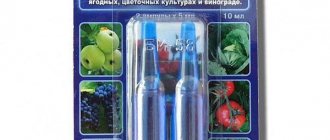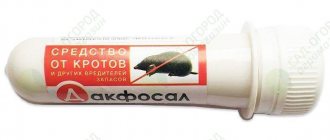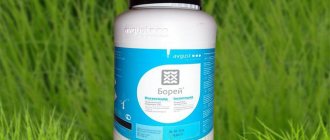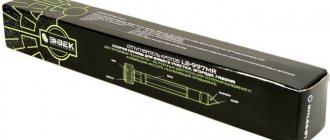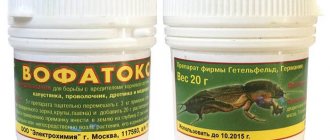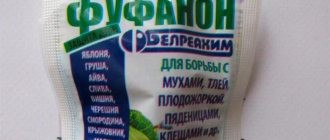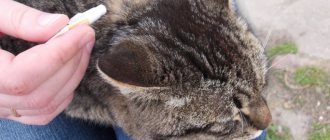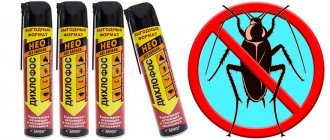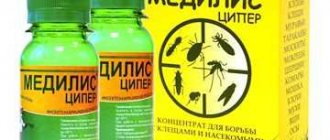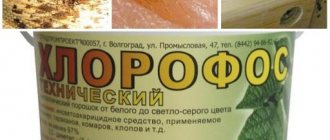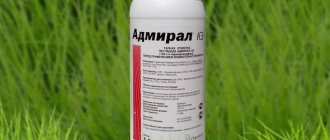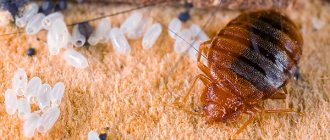One of the most effective and proven means for combating arachnid pests is Anti-Mite for Spider Mites, the instructions for which contain a table for preparing the solution. This table is necessary, since this product is suitable for processing many crops - these include vegetables, berries, fruits and, of course, flowers.
More than 200 different plant species suffer from spider mites; this pest can spread quite quickly and develop special immunity to various chemicals that are used to eradicate it. It poses a serious danger to crops growing both in open ground and in greenhouses and pots.
Spider mites can infect almost all types of plants, except those that grow in water. These small pests live in large colonies, sometimes numbering more than a hundred units. They live, as a rule, under the lower part of the leaf or in the surface layers of the soil. They feed on plant sap, which leads to their defeat.
Where this type of mite actually lives, you can find a barely noticeable and very thin web with which the insect envelops the leaf or stems. The web at the base of the cutting and the bottom of the leaf is a sure sign of plant damage by spider mites. There are many varieties of such pests; to combat them, the drug Antiklesch is used, which shows high efficiency in its work and has a fairly long period of protective action.
Active substance and formulation
"Anti-tick" is a contact-intestinal acaricide that helps to cope with most types of ticks. It is especially effective against the spider variety of parasites. The composition can be used for processing different types of crops - vegetables, berries, fruits. The drug is suitable for use on private farms.
The substance is released in the form of an emulsion concentrate. It is sold in 10 ml containers. The active ingredient is malathion. 1 liter of product contains 525 grams of the substance.
Folk remedies
There are a lot of traditional ways to combat ticks. Below are the most effective and easy to prepare.
- A decoction of black henbane. Take 1 kg of dried and chopped henbane leaves and pour 10 liters of boiling water. Let it sit for 12 hours, strain and add 40 g of liquid laundry soap. Soap is added so that the solution lingers on the leaves and does not roll off immediately.
- A decoction of medicinal dandelion. For 10 liters of hot water, take 500 g of fresh leaves or 300 g of dry roots. The broth should stand for a day, after which it must be strained and you can water the plants.
- Decoction of field chamomile. Take 1 kg of dry chamomile per 10 liters of hot water. Let it brew for 12 hours. After this, strain, dilute with water, add 40 g of soap and you can begin processing.
- Garlic solution. Take 30 g of garlic per bucket of water. The solution is infused for about a day in a dark place. You can add laundry soap.
- Onion infusion is also effective in the fight against ticks. Take 200 g of fresh husk and fill it with warm water. The decoction is left for 12 hours, then filtered and applied as directed on the affected plants.
- Hot peppers. Take 50 g of red hot pepper per 500 ml of water. Spray the leaves.
- Hydrogen peroxide 3% is used in a proportion of 20 ml per 1 liter of settled water. Hydrogen peroxide works best against mites. Safe for humans, there is no odor and the effect appears immediately.
- You can use a vinegar-based solution. Vinegar is harmful to ticks.
Resistant varieties of cucumbers:
It is difficult to find cucumber varieties that are resistant to spider mites, but there are hybrids that are characterized by increased immunity and resistance to most diseases: Stork, Aquarius, Unity, Lotus, Phoenix, Khabar, Electron, Golubchik, Debut, Zhuravlenok, Katyusha, Idol, Nightingale.
Spectrum and mechanism of action of the drug "Antiklesch"
The substance is characterized by a unique ovicidal effect. To cope with eggs and larvae of spider mites, literally one spray will be enough. At the same time, the drug has a gentle effect on the natural enemies of parasites. The product is devoid of phytotoxic properties.
Expert opinion
Zarechny Maxim Valerievich
Agronomist with 12 years of experience. Our best country expert.
Ask a Question
With a single timely spraying of plantings, the product helps protect them from ticks for 2-3 months. It is important to carry out the treatment before the larvae revive.
The drug helps to cope with different types of ticks. It can be used for processing berry plants, fruit crops, vineyards or hops.
Prevention of spider mites on cucumbers
Crop rotation is a key requirement for spider mite prevention. Since cucumbers are the pest’s favorite food, they cannot be planted twice in the same place. Tomatoes and eggplants are rarely affected by the parasite due to the presence of numerous hairs on the leaves.
Remove weeds around the borage in a timely manner. This reduces the chance of infection. Since the spider mite initially appears there, and only then moves to vegetables.
Plant beds with cucumbers with crops that repel spider mites. Such properties are characteristic of calendula, basil, onion, garlic and parsley.
Constantly monitor the crop in order to notice the pest in time and take the necessary control measures.
Advantages and disadvantages
Advantages and disadvantages
high efficiency;
wide spectrum of protective action;
versatility of use;
quick effect - observed half an hour after exposure;
lack of phytotoxic properties for plants and low toxicity for warm-blooded animals;
long-term protective effect - it lasts for 25 days;
effectiveness at all stages of parasite life;
compatibility with various crop protection products.
The drug has virtually no disadvantages. The main disadvantage is the need to strictly follow the instructions and use personal protective equipment.
See also
Instructions for use of chlorpyrifos, safety measures and harm to humansRead
Preventive measures
Amateur gardeners should remember how quickly mites reproduce on indoor plants and how to fight them by combining various methods. Prevention of infection is equally important. Most often, the pest enters a houseplant in the following way: together with another indoor flower, with store-bought soil and through an open window. Simple rules will help prevent infection:
- Humid air is harmful to ticks. Regular irrigation with water will help protect indoor flowers from pests.
- It is advisable to dry store-bought soil in the oven.
- You cannot place a plant brought from the store next to other flowers. A newly purchased flower must undergo quarantine for 10-12 days in a separate room.
- For preventative purposes, you need to wipe the window sill and frames with detergent. This measure will help destroy ticks brought by the wind from the street.
Instructions for use
To ensure that the drug does not cause harm to health and has a good effect, it is important to strictly adhere to the recommendations specified in the instructions. The composition belongs to the category of water-soluble emulsions. The instructions say that 10 milligrams of the substance must be mixed with 10 liters of water.
To mix the working solution, do the following:
- pour 2 liters of clean water into a bucket;
- open the package, enter the required volume of emulsion;
- mix everything well;
- add the solution to the required volume and mix again;
- pour into a sprayer;
- The solution remaining after use cannot be stored.
Crops must be processed early in the morning or in the evening. It is important to ensure that the wind speed is no more than 2 meters per second.
Harm and danger of mites for cucumbers
In order to identify the causative agent of cucumber damage at an early stage, you need to check the inside of the leaf daily. With a large greenhouse area, this process is extremely difficult and even impossible. This is why a tick is discovered only after it has multiplied and a web has appeared. Weak bushes at this stage can rarely be saved.
How do mites infect greenery?
When settling on the underside of a leaf, the pest pierces it and sucks out the juice. The plant becomes exhausted, dries, turns yellow and dies.
Another danger lies in the rate of reproduction. The mite infects all the bushes in a short time, forming a web between the stems that repels water well. As a result, chemical treatment sometimes does not give the desired effect.
Female ticks lay up to 400 eggs at a time. There can be from 15-20 such cycles per year. The optimal temperature for reproduction is from +23 to +33 degrees.
Safety precautions when working with Antiklesch
The product belongs to the third hazard class. This means that it is considered a moderately hazardous substance. To avoid problems when processing cultivated plants, you should carefully observe all precautions during the preparation of the emulsion. This is done during and after direct spraying.
The drug must be kept only in its original packaging. It should be in a cool place with adequate ventilation. It is important to keep it separate from medicines, seeds, food products, and fodder. The product must be kept out of the reach of children and animals.
When processing cultivated plants, it is recommended to use personal respiratory protection, gloves, and work clothes.
Risk factors for tick bites
Ixodid (encephalitis) ticks are the source of the most dangerous encephalitis viral infection, posing a serious danger to the health of humans and their pets. Delayed assistance can lead to death.
The main danger of ticks is the transmission of tick-borne encephalitis . Tick-borne encephalitis is a viral inflammation of the central and peripheral nervous system, leading to memory and intelligence disorders, and severe complications can result in paralysis and even death. In addition, they are carriers of relapsing tick-borne typhus , tick-borne typhus, tularemia, hemorrhagic fever, ehrlichiosis and other diseases.
Every year, up to half a million citizens of our country seek medical help for tick bites!!!!!, about 30% of them are children.
For dogs or other animals, the consequences of a tick bite are also catastrophic. So in dogs, in a latent form without treatment, tick-borne encephalitis leads to 95% mortality.
A dog tick bite can lead to dangerous viral diseases:
- piroplasmosis (destruction of hemoglobin cells with damage to all internal organs);
- encephalitis (nervous disorders leading to blindness, paralysis of the limbs);
- borreliosis or Lyme disease (inflammation of the joints, leading subsequently to chronic painful arthritis);
- bartonellosis (disorders of the nervous system, the dog loses orientation in space and cannot walk correctly);
- hepatozoonosis (purulent discharge from the eyes, muscle pain and severe fever).
How to protect yourself and your pets from tick bites? How to protect yourself from such serious consequences? How to provide emergency assistance? What does tick bite prevention include?
First aid
At the first symptoms of poisoning, you should stop working, remove the victim from the area of exposure to the substance, and carefully remove dirty clothing and protective equipment. In this case, it is necessary to avoid possible contact of the substance with the skin or respiratory organs. There must be a flow of fresh air into the room. Then you definitely need to call a doctor.
First aid for poisoning with a substance depends on the area of exposure:
- If the composition penetrates the respiratory organs, the person must be taken to fresh air.
- If the composition gets on the skin, remove it with a piece of soft paper, cloth, or cotton wool. At the same time, you should not rub the skin roughly. After which you need to wash the contaminated area with soapy water.
- In case of contact with eyes, rinse immediately with clean running water.
- In case of accidental ingestion, rinse the mouth with water and give the victim several glasses of activated carbon solution. It is recommended to use 1 gram of the drug per 1 kilogram of weight. Then, by irritating the posterior pharynx, provoke vomiting and carry out this procedure several times. Then you need to take another 1 glass of activated carbon solution and immediately consult a doctor.
See also
Instructions for use of Cruiser insecticide and seed protectantRead
In case of poisoning with Anti-Tick, it is necessary to use specific antidotes. The most effective agents include toxogonine and atropine sulfate.
Prevention of pest occurrence
In addition to means of combating spider mites, comprehensive prevention is also important.
It can be divided into 3 stages:
- in the spring - preparation;
- all season - current;
- before wintering - final.
In the spring, you need to clean the room after wintering and sterilize the soil. For this:
- wash the greenhouse structure with soapy water, after adding chlorine to it;
- dig up the soil to 25-30 cm;
- treat it with boiling water;
- cover the soil tightly with film for 3 days;
- fumigate the room with sulfur bombs;
- spill the soil with a one percent manganese solution.
During ongoing prophylaxis:
- high humidity must be maintained in the greenhouse;
- plant plants at a distance of one and a half meters;
- regularly inspect planted vegetables;
- remove parts of leaves on bushes;
- mulch the soil;
- spray the soil and plants with onion infusion.
Autumn:
- completely remove plant debris and various auxiliary structures;
- Dig the soil carefully, adding lime or phosphate fertilizers.
ACTUAL NEWS
You may also find the following materials useful:
- Pharmacy activated carbon: top 8 options for use in the country
- Why does the earth crack after watering, and what to do in this situation
- The best remedies for late blight on tomatoes: the most effective, how to treat
- What can be made from tomato tops: use herbal infusions
- When and what to feed garden cabbage: the best options for organic fertilizers
IMMUNIZATION/VACCINATION
a) for a person
The vaccine is the most effective way to protect against tick-borne encephalitis.
Vaccines currently used in humans are:
- Klesh-E-Vac or EnceVir , manufactured in the Russian Federation based on Far Eastern strains.
- FSME-Immun/Junior , manufactured in Austria and Germany, respectively, based on European strains of the virus;
Russian and imported vaccines are similar in structure and therefore are interchangeable; they can be changed during one vaccination: for example, administer the first dose with a Russian drug, and the second and third with an imported one.
Vaccination against tick-borne encephalitis takes place in several stages. There are several vaccination schedules that differ slightly in the timing of administration.
Approximate VACCINATION SCHEME for humans:
- 1 vaccination
- 2nd vaccination - after 1-3 months
- 3rd vaccination - after 12 months.
- After three years - revaccination, repeated every three years.
Vaccination against tick-borne encephalitis.
Examples of vaccines Immune protection against tick-borne encephalitis appears approximately two weeks after the second dose of the vaccine, regardless of which drug was administered. Failure to schedule vaccination may prevent the development of a full immune response.
The first dose is best administered in March. It is important to understand that the likelihood of being bitten by a tick is the same for a vaccinated and unvaccinated person. Immune protection is formed in more than 87% of those vaccinated against tick-borne encephalitis. Even if infection occurs, the disease will be much milder than in unvaccinated people, and, as a rule, without complications.
The vaccination procedure is carried out strictly according to indications and with a referral (authorization) from a doctor. Vaccination is contraindicated for any acute diseases, as well as chronic diseases in the acute stage, severe allergies, especially to egg whites, severe reactions to the previous dose of the vaccine (for example, fever above 40°C) and pregnancy
Unfortunately, in Russia more than 5-7% of Russians are vaccinated annually. In Austria, for example, more than 90% of Austrians have been vaccinated against the virus.
b) for pets (dogs, etc.)
Vaccination of a dog - prevention of tick bites
As for domestic animals, the following VACCINES are used for vaccination:
- " Nobivac Piro"
- " Eurican Piro " (Eurican Piro);
- " Pirodog " (Pirodog), etc.
Tick bite prevention for pets includes the use of TICK TABLETS FOR DOG. The tablets are classified as insecticides; they differ fundamentally from each other in composition and the active substance used (fluralaner, afoxolaner, spinosad, milbemycin, sarolaner, etc.)
Among the most used today:
- «Bravecto»
- «Frontline NexgarD»
- «Nexgard Spectra»
- «Simparinka»
- " Comfortis " and others.
| READ MORE: “Tick tablets for dogs – TOP 5 best (comparative analysis)” |
PROTECTIVE CLOTHING
a) for a person
For a short stay in nature, it is advisable to dress in light-colored clothing made from thick fabrics. Fasten the collar and cuffs, tuck the trousers into shoes/socks - minimize exposed areas of the body. A headdress is required - a cap/kerchief. For tourists, hunters, forestry workers, special protective suits “Taiga”, “Tourist” or others are used.
Special protective suits - reliable protection against tick bites
The BioStop brand produces suits combining the mechanical and chemical principles of protection. Special flounces located on the suit act as traps for ticks crawling upward. Inside the shuttlecock there is an insert impregnated with an acaricidal substance that is lethal to ticks. Under its influence, the tick dies within a few minutes and falls off the clothing.
b) for pets
For pets, protective anti-tick collars (chemical, biological or ultrasonic) are used.
The most commonly used are collars based on the chemical principle of action (with an insectoacaricidal drug applied):
- " Foresto " (Bayer, Germany);
- " Kiltix " (Bayer, Germany);
- " Scalibor " (France);
- " Beaphar " (Netherlands);
- " Bars " (Russia).
| READ MORE: “Tick collar for dogs – how to choose? TOP 5 best" |
